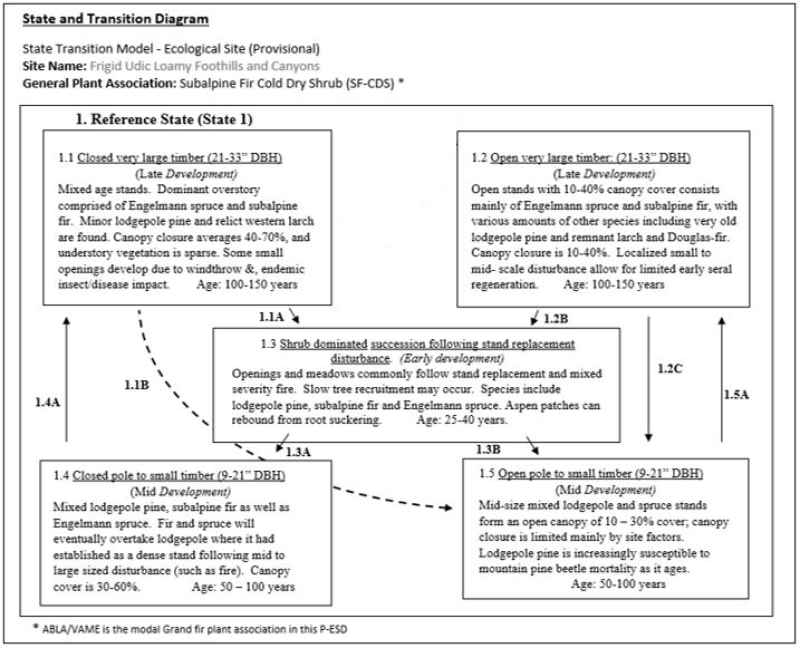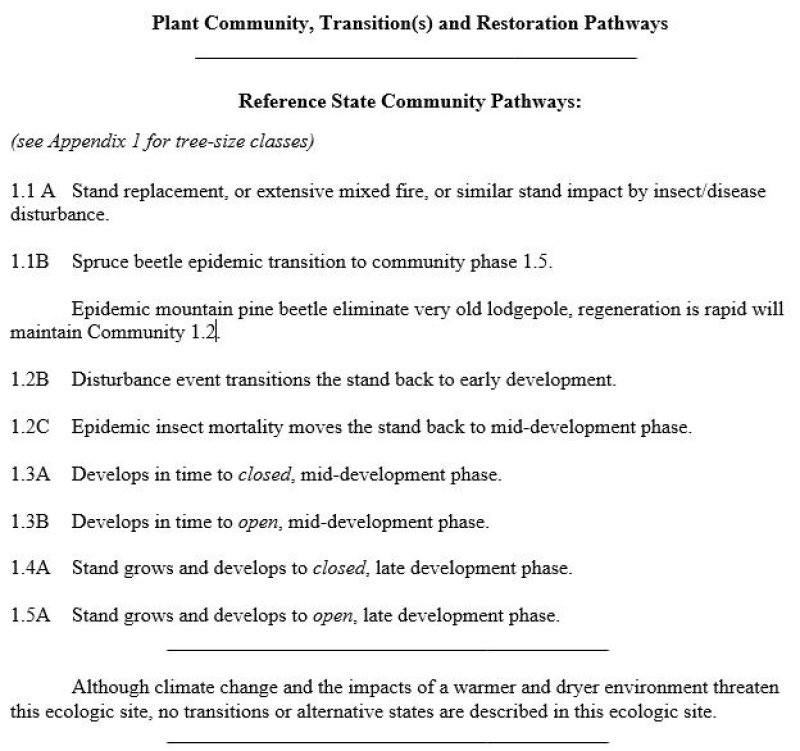Ecological dynamics
ECOLOGICAL DYNAMICS OF THE SITE
The subalpine fir cold dry (SF -CDS) ecological site is made up of a singular plant association, Subalpine fir (Abies lasiocarpa)/grouse whortleberry (Vaccinium scoparium), abbreviated as ABLA/VASC. This plant association is identified in the plant association group as “cold-dry”, and in the broader plant vegetative type group as a “cold upland forest .”
This ecological site occupies the highest forested elevations in MLRA 43C. It is found on all aspects, over a wide variety of slope positions and gradients.
The historic long-term climatic expression of this ecologic site is characterized by cold winters and cool summers, where frost can occur in any month of the summer season. Snowfall amounts are high, and the accumulated snowpack lingers long into the summer months.
As the global climate continues to warm, these climatic parameters will shift towards dryer and warmer expressions, impacting the basic attributes this ecologic site and changing the nature and structure of the forests in the area.
Engelmann spruce (Picea engelmanii) often dominates post-disturbance stands in mid- to late community development stages, but subalpine fir easily establishes in the understory shade of the mature spruce forest. For these reasons, both subalpine fir and Engelmann spruce (which is a persistent, long lived conifer) are common overstory associates in mature, late seral forests. Although these two species are typically co-dominate in the stand, subalpine fir is considered the climax series.
As a species, subalpine fir is well adapted to long fire free intervals, where fires that do occur are either stand replacement or mixed fire events. Conversely, individual subalpine fir trees rarely survive any type of fire because of the thin bark, shallow rooting structure, and dense branching characteristics which often continue down to the surface of the ground. Needle foliage and crowns are highly flammable, and many older trees contain abundant lichen growth.
Although it is very shade tolerant, subalpine fir is often the pioneer conifer species on harsh sites, and it establishes well in the absence of plant competition under partial sunny conditions.
Engelmann spruce is well adapted to recover rapidly following mixed or stand replacement fire occurrences. It produces abundant seed crops which have good viability and are well dispersed by wind. Engelmann spruce requires mineral soils in order to achieve optimum levels of seedling germination and subsequent establishment, and it will germinate in all light conditions although it does best under shady conditions. Young spruce seedlings growing under full sun exposure will often succumb to the late summer impacts of solar radiation, which results in drought or heat girdling losses.
Engelmann spruce shares many of the same attributes as subalpine fir regarding individual tree susceptibility to wildfire.
Douglas-fir (Pseudotsuga menziesii) is a mid-seral component of this ecological site. It generally favors the lower or southerly aspects within the ecological site, as the species is approaching the upper limits of its ecological tolerance (i.e. ecological “amplitude”) to cold. Isolated, very old age individual Douglas-fir remnant trees can be found in parts of this ecological site. In some instances Douglas-fir can be a viable component of mid and late seral stands on more favorable sites.
Lodgepole pine (Pinus contorta), limited amounts of western larch (Larix occidentalis), and quaking aspen (Populus trichocarpa) are all early seral tree species which can aggressively occupy severely disturbed sites when conditions are favorable. Disturbances (i.e. wildfire or endemic insect outbreaks) initiates the process of lodgepole pine regeneration. Lodgepole pine produces viable seed crops at a relatively early age, and both serotinous and nonserotinous cones are common, allowing regeneration to occur with and without fire. Persistent, self-replacing lodgepole pine stands do not typically occur in the ecologic site due to long fire free interval periods, but when a major wildfire does occur dense stands of lodgepole pine often develop. These stand(s) could persist for 100’s of years in the absence of replacement by mid to late seral conifers, aided by reoccurring stand replacement event(s) which favors lodgepole pine reestablishment. In this case lodgepole begins to act as a dominant seral species, but the more typical route of succession introduces shade tolerant spruce and subalpine fir into the understory of lodgepole pine stands, eventually overtopping and dominating the stand in far less time.
Western larch is an extremely fast growing early seral conifer. It is the most fire adapted conifer in this ecologic site. Mature trees have thick bark, along with high open branches that are very resistant to torching. Western larch will persist into late seral community phases, and will typically survive even the most extreme level of fire, enabling it to seed the emerging post-fire forest communities. Larch establishes well under full sunlight.
In this ecologic site, small aspen stands are scattered among the more extensive spruce-fir stands. Quaking aspen stands are very resistant to fire because of the moist environment in which they occur. However individual aspen trees, smaller sized aspen patches, or stands in close proximity to flammable conifers are killed when wildfires sweep across the larger landscape. Aspen typically responds following fire to produce above ground stems that have sprouted (i.e. “sucker”) from underground roots.
Both lodgepole pine and aspen can quickly establish following catastrophic wildfire events, and at times can be found together in mixed stands. When these two tree species regenerates in significant amounts, they can overtop and outcompete newly emerging Engelmann spruce and subalpine fir seedlings.
Wildfire, in the form of stand replacement and mixed severity events, typically reoccur on an equal 50-50 frequency in the ecologic site over a long period of time. These types of fires also share a common long term “mean fire return interval” (MFRI) of approximately 200 years for both disturbance types, but the overall MFRI for any individual fire event is 125 years. Surface fire is essentially absent from this ecologic site.
In addition to fire disturbance, the SF-CDS ecologic site is also impacted and changed by periodic windthrow, and by significant insect and disease disturbances (typically when these occur at an epidemic rather than an endemic level).
Other biotic and abiotic disturbance factors for the common conifers of the ecologic site:
• Engelmann Spruce is impacted by spruce and western spruce budworm, wood rotting fungi, broom rusts and windthrow. Armillaria and laminated root disease susceptibility is moderate.
• Subalpine fir is also impacted by spruce and western spruce budworm, as well as by bark beetles (such as fir engraver), non-native balsam aphid, and tussock moth. Anosus root disease and Indian paintbrush fungus affect subalpine fir, and it is also prone to windthrow.
• Western larch is attacked by the dwarf mistletoe parasite. It is also impacted by needlecast and red ring rot, as well as by western spruce budworm and larch casebearer. Larch is not prone to windthrow except in rare instances, and is relatively free of most root disease.
• Douglas-fir suffers from tussock moth and other insect defoliators and dwarf mistletoe, and is susceptible to armillaria and laminated root disease.
• Lodgepole pine is attacked by mountain pine beetle, pine engraver, weevils, mistletoe and various fungi causing stem canker and gall rust. It is moderately susceptible to
armillaria root disease.
Moisture loving understory species occur in the understory of mature forests. Big huckleberry (Vaccinium membranaceum) grouse whortleberry, prince’s pine (Chimaphila umbellata), and heartleaf arnica (Arnica cardifolia) are common.


